40 Years Ago: Preparations for STS-2, Columbia’s Return to Space
In August 1981, NASA was busy preparing Space Shuttle Columbia for its first return to space on the STS-2 mission. At NASA’s Kennedy Space Center in Florida, ground crews had installed the payload in Columbia’s cargo bay, including the Canadian-built robotic arm for its first test in space. Following interface tests between the orbiter and its payloads, workers towed the vehicle to join it with its external tank (ET) and solid rocket boosters (SRBs) in the Vehicle Assembly Building (VAB). The prime crew of Joe H. Engle and Richard H. Truly, along with backups Thomas K. Mattingly and Henry W. “Hank” Hartsfield, participated in integrated tests of the stacked vehicle prior to Columbia’s rollout to Launch Pad 39A on Aug. 31, preparing for a launch then planned for Oct. 9.
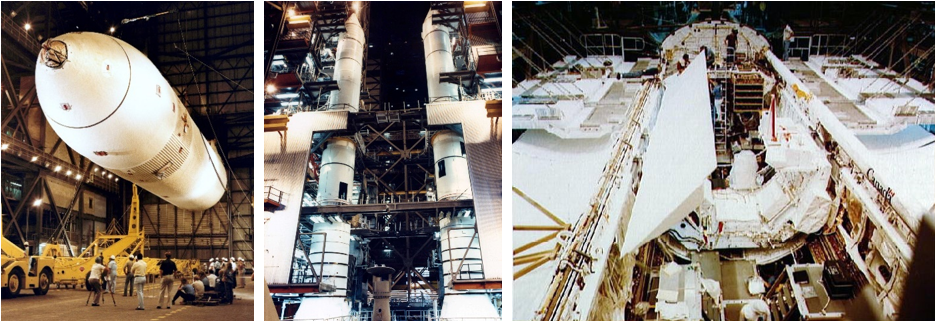 Left: The external tank for the STS-2 mission shortly after its arrival in the Vehicle Assembly Building (VAB) at NASA’s Kennedy Space Center in Florida. Middle: The SRBs stacked on the mobile launch platform inside the VAB. Right: In Kennedy’s Orbiter Processing Facility, the OSTA-1 payload and the Canadian-built remote manipulator system installed in Columbia’s payload bay. Credits: NASA
Left: The external tank for the STS-2 mission shortly after its arrival in the Vehicle Assembly Building (VAB) at NASA’s Kennedy Space Center in Florida. Middle: The SRBs stacked on the mobile launch platform inside the VAB. Right: In Kennedy’s Orbiter Processing Facility, the OSTA-1 payload and the Canadian-built remote manipulator system installed in Columbia’s payload bay. Credits: NASA
Following its highly successful first flight on STS-1 with astronauts John W. Young and Robert L. Crippen, Columbia returned to Kennedy on April 28, 1981, where ground teams began preparing the reusable vehicle for its return to space on STS-2. The ET for STS-2 arrived on April 22 to undergo inspection and checkout. Workers completed assembly of the twin SRBs on the mobile launch platform in early June and mated the ET with the SRBs on June 30. In the Orbiter Processing Facility (OPF), technicians replaced about 1,300 tiles of the orbiter’s thermal protection system. Workers installed the Spacelab pallet, containing five experiments of the Office of Space and Terrestrial Applications-1, or OSTA-1, payload, and the Canadian-built remote manipulator system (RMS), or robotic arm, into Columbia’s payload bay on June 29. STS-2 marked the first shuttle flight to carry science experiments and the first use of the RMS. On July 29, engineers completed a two-day Orbiter Integrated Test to verify that software and hardware in Columbia and in the payload complement were compatible.
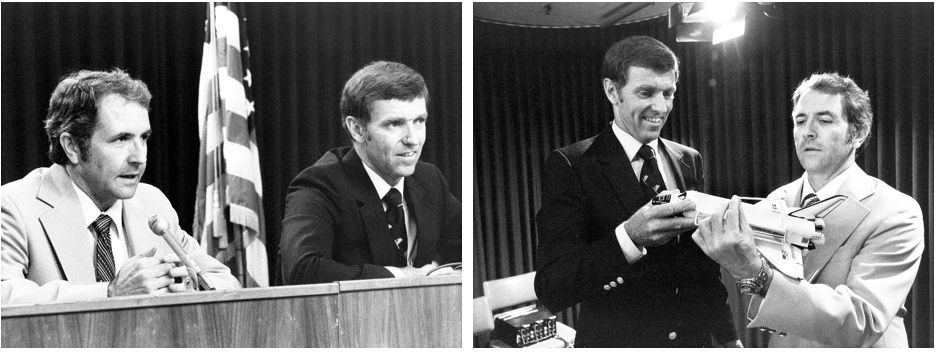
Left: STS-2 astronauts Richard H. Truly, left, and Joe H. Engle answer reporters’ questions during the preflight press conference. Right: Engle, left, and Truly demonstrate space shuttle components to reporters during the preflight press conference. Credits: NASA
On Aug. 3, at NASA’s Johnson Space Center in Houston, Engle and Truly held their preflight press conference to describe their planned five-day, six-hour mission — at the time targeted for a Sept. 30 launch. The astronauts understood that the launch date depended on the progress of processing and testing of the vehicle, with Engle declaring, “We’re going to be ready when the bird’s ready.”
The two described the major tasks of their mission, including testing the mobility and grasping capability of the RMS, operating the OSTA-1 experiments, and continuing engineering tests of the new vehicle. Noting that STS-2 was only the second flight of the shuttle test program, Truly said, “Our mission rules are very conservative. If we have a failure and our mission rules cause us to come home early, we will do that. I would still call it a successful flight.”
With that in mind, mission planners scheduled the more critical tests for the first two days of the mission.
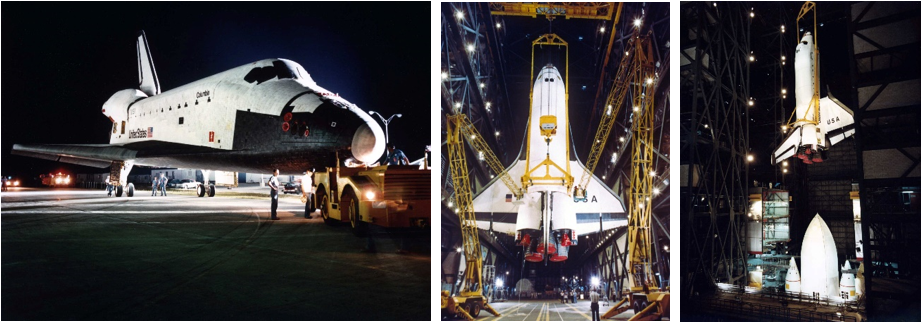 Left: At Kennedy, workers tow Columbia from the Orbiter Processing Facility to the VAB. Middle: Ground crews in the VAB lift Columbia in preparation for mating with the ET and SRBs. Right: Ground crews prepare to lower Columbia for mating with the ET and SRBs. Credits: NASA
Left: At Kennedy, workers tow Columbia from the Orbiter Processing Facility to the VAB. Middle: Ground crews in the VAB lift Columbia in preparation for mating with the ET and SRBs. Right: Ground crews prepare to lower Columbia for mating with the ET and SRBs. Credits: NASA
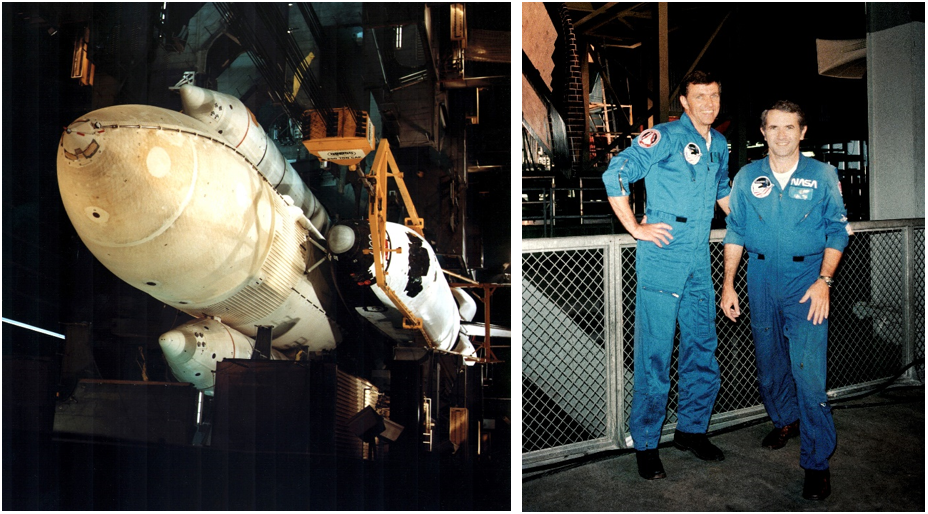
Left: Inside the VAB at Kennedy, workers mate Columbia to its ET and SRBs. Right: STS-2 astronauts Joe H. Engle, left, and Richard H. Truly inside the VAB, preparing to participate in the Shuttle Interface Tests. Credits: NASA
In the predawn hours of Aug. 10, ground crews backed Columbia out of the OPF and towed it the short distance to the VAB. Workers there first lifted the orbiter six inches off the ground to retract its landing gear, then tilted it vertically and raised it 190 feet in the air to then lower it to join the assembled ET and SRBs on the mobile launch platform. On Aug. 26, engineers completed a nine-day Shuttle Interface Test, designed to check out the mechanical and electrical connections between the orbiter, ET, SRBs, and the functioning of the onboard flight systems. The prime and backup crews participated in the tests by conducting simulated countdowns and simulating two ascent profiles — one nominal and one return-to-launch-site abort, and one entry and landing profile. Although all the tests were completed successfully, cumulative delays in various activities caused mission managers to slip the target launch date to Oct. 2.
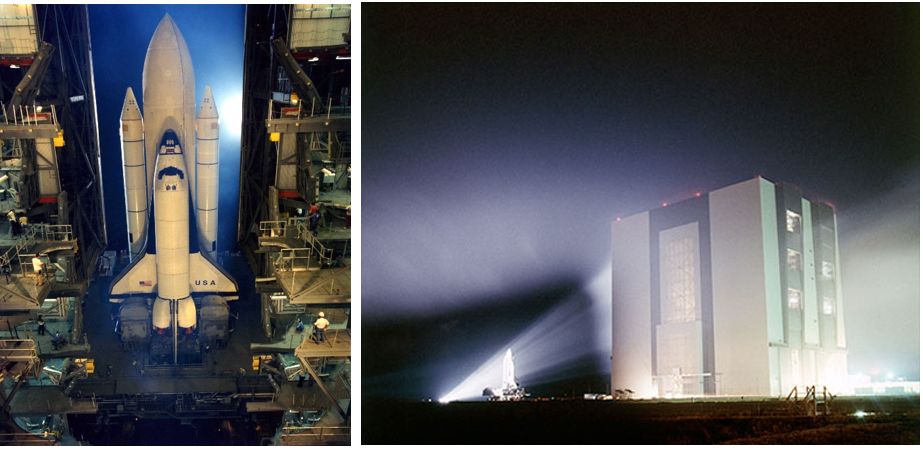
Left: Space Shuttle Columbia prepares to leave the VAB at Kennedy for its rollout to Launch Pad 39A. Right: Columbia, lit by floodlights, leaves the VAB to begin its seven-hour trek to Launch Pad 39A. Credits: NASA
 Images of Columbia’s seven-hour trek out to Launch Pad 39A in preparation for STS-2. Credits: NASA
Images of Columbia’s seven-hour trek out to Launch Pad 39A in preparation for STS-2. Credits: NASA
At 4:45 a.m. on Aug. 31, Space Shuttle Columbia began its slow rollout to Launch Pad 39A, making the 3.5-mile journey in a little more than seven hours. Following completion of this significant milestone, mission managers targeted the next major event, the countdown demonstration test, for mid-September, and the actual launch for Oct 9.
To be continued …
World events in August 1981:
- Aug. 1 – MTV premieres at 12:01 a.m.
- Aug. 3 – About 13,000 air traffic controllers go on strike. President Ronald W. Reagan orders them back to work or face termination, but only 1,300 do so.
- Aug. 5 – President Ronald W. Reagan fires 11,345 striking air traffic controllers.
- Aug. 12 - IBM introduces its first Personal Computer (PC & PC-DOS version 1.0).
- Aug. 13 – The last episode of “The Waltons” airs on CBS.
- Aug. 25 – Voyager 2 spacecraft makes its closest approach to Saturn.







